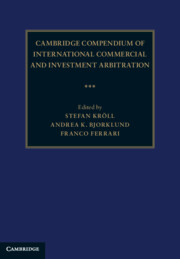Book contents
- Cambridge Compendium of International Commercial and Investment Arbitration
- Cambridge Compendium of International Commercial and Investment Arbitration
- Copyright page
- Contents
- Figures
- Tables
- Contributors
- Preface
- Part I Foundations
- Part II Public Law Questions Relating to Arbitration
- Part III Stakeholders in Arbitration
- Part IV Applicable Law
- Part V Jurisdiction of the Arbitrator
- Part VI The Arbitral Tribunal
- Part VII Procedural Questions in Arbitration
- Part VIII Role of State Courts in Arbitration
- Part IX Awards
- Part X Post-Award Issues
- Part XI Legal Concepts
- Part XII Areas of Concern
- Part XIII Arbitration and Related Fields
- Part XIV EU Law and Arbitration
- 65 European Union Law in Arbitration Proceedings: Status and Methods
- 66 The European Court of Human Rights and Arbitration
- 67 EU Law and Investment Arbitration: Of Cooperation, Conflict, and the EU Legal Order’s Autonomy
67 - EU Law and Investment Arbitration: Of Cooperation, Conflict, and the EU Legal Order’s Autonomy
from Part XIV - EU Law and Arbitration
Published online by Cambridge University Press: 18 February 2023
- Cambridge Compendium of International Commercial and Investment Arbitration
- Cambridge Compendium of International Commercial and Investment Arbitration
- Copyright page
- Contents
- Figures
- Tables
- Contributors
- Preface
- Part I Foundations
- Part II Public Law Questions Relating to Arbitration
- Part III Stakeholders in Arbitration
- Part IV Applicable Law
- Part V Jurisdiction of the Arbitrator
- Part VI The Arbitral Tribunal
- Part VII Procedural Questions in Arbitration
- Part VIII Role of State Courts in Arbitration
- Part IX Awards
- Part X Post-Award Issues
- Part XI Legal Concepts
- Part XII Areas of Concern
- Part XIII Arbitration and Related Fields
- Part XIV EU Law and Arbitration
- 65 European Union Law in Arbitration Proceedings: Status and Methods
- 66 The European Court of Human Rights and Arbitration
- 67 EU Law and Investment Arbitration: Of Cooperation, Conflict, and the EU Legal Order’s Autonomy
Summary
The influence of the EU and EU law on investment arbitration is one of the hotly debated topics in today’s arbitration world. Since the EU obtained the competence for the regulation of foreign (direct) investment on behalf of its Member States through the 2009 Lisbon Treaty, the European Commission’s efforts have brought about much change for both the EU’s internal and the EU’s external investment law relations. On the EU-internal level, the Commission – since 2018 backed by the European Court of Justice’s Achmea judgment and since early 2019 also by the EU Member States – has worked towards the elimination of investment arbitration. It seeks to have these disputes litigated before EU Member State courts instead. On the EU-external level, the Commission has successfully negotiated a new dispute settlement model in the EU’s free trade and investment agreements: an investment court system, the compatibility of which with EU law the Luxembourg court confirmed in 2019. This chapter seeks to set out these developments in a structured manner. It is necessarily incomplete, since the interaction between the Commission, investment tribunals, courts and other actors continues to develop – despite the fact that this interaction to a considerable degree remains determined by mutual ignorance.
Keywords
- Type
- Chapter
- Information
- Publisher: Cambridge University PressPrint publication year: 2023
- 1
- Cited by

